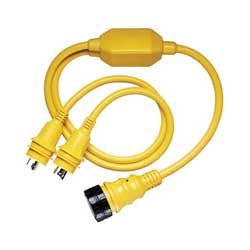rslifkin
Guru
- Joined
- Aug 20, 2019
- Messages
- 7,584
- Location
- USA
- Vessel Name
- Hour Glass
- Vessel Make
- Chris Craft 381 Catalina
I just don't see any grave danger in a 50A 125/250 cord being split into 2 30's.
The short splitter is the only "under-protected" wire and is aboard where it probably has little or no real threat to it.
Just overworrying in the big scheme of boating threats....unless I read it wrong...they are UL approved so not sure why the distrust.
Typically a boat with twin 30s would use 2x 30 amp cords and put the splitter at the pedestal end, I'd expect. That way they don't need different cords for a marina with only 30 amp outlets. My biggest concern for under-protected wiring in that situation is the inlets on the boat and the run from the inlet to the breaker. Much worse consequences if an issue occurs there, and it's just as under-protected.

